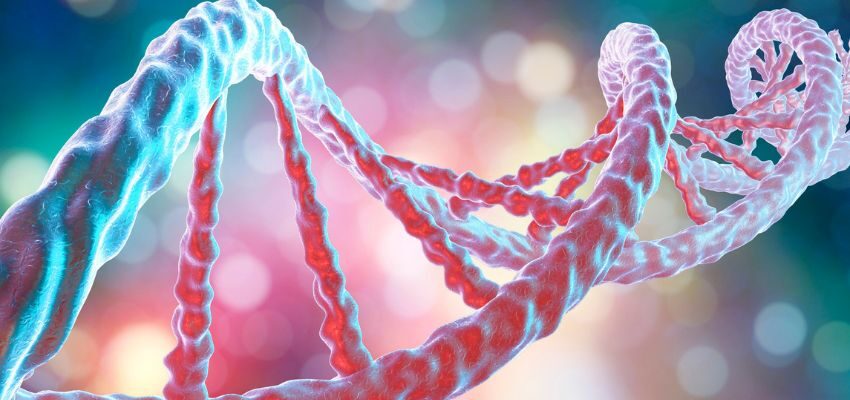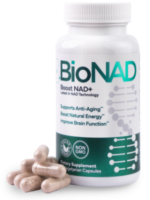NADH vs NAD+: Everything You Need To Know

Published June 7, 2024
NAD+ (nicotinamide adenine dinucleotide) is a coenzyme in every living cell. Often referred to simply as NAD, the plus sign is frequently omitted. However, this plus sign is crucial as “NAD” includes different forms of the molecule, specifically NAD+ and NADH.
In this article, we’ll examine the distinctions between NADH vs NAD+. We’ll explore their respective roles in maintaining cellular health.
NADH Vs NAD+: What Is The Difference?
NAD+ and NADH are two forms of nicotinamide adenine dinucleotide. They are crucial coenzymes in cellular metabolism. NAD+ is the oxidized form, while NADH is the reduced form. They work together in redox reactions, which are pivotal in the electron transport chain to facilitate cell energy creation. These processes are essential for converting nutrients into ATP (adenosine triphosphate), the cell’s primary energy currency. Generally, it supports various biological functions and overall cellular health.
What Is NAD+?
NAD+ is crucial for optimal cellular function. Mitochondria, the cell’s “powerhouse,” relies on it as the primary electron carrier. These membrane-bound organelles in almost every living cell generate most of the energy needed for biochemical reactions. This energy is stored in molecules of ATP.
Energy Generation
NAD+ is a carrier of electrons in the energy-producing processes in the mitochondria. This crucial molecule is pivotal in various metabolic pathways, including the Krebs cycle, glycolysis, and the electron transport chain.
NAD+ helps transfer electrons. This process generates ATP, the cell’s primary energy currency. ATP supports cell functions and overall energy metabolism. Its importance extends to numerous biochemical reactions and maintaining cellular health.

Sirtuins
NAD+ is essential for the function of sirtuins, a family of proteins crucial in regulating cellular health. Sirtuins are involved in many critical processes, including DNA repair, gene expression, and aging regulation. They help maintain the integrity of the genome and ensure that cells function optimally.
Research has shown that sirtuin activation can have beneficial effects on lifespan and overall health. This makes them a significant focus of studies related to aging and age-related diseases.
Decline With Age
NAD+ levels naturally drop with age, resulting in various age-related health issues. This decline is linked to reduced mitochondrial function, heightened oxidative stress, and a higher chance of developing chronic diseases.
As we age, cells become less efficient. This contributes to slower metabolism, lower energy, and impaired DNA repair. This reduction in NAD+ also plays a significant role in aging. It makes conditions like neurodegenerative diseases, heart problems, and metabolic disorders worse.
What is NADH?
NADH is also known as coenzyme 1. It’s the activated carrier molecule that moves electrons within the cell. The “H” symbolizes hydrogen, highlighting that the molecule is the most active.
Conversion Of NAD+ To NADH
NAD+ transforms into NADH by accepting an electron and a hydrogen ion during cellular respiration. This crucial biochemical reaction happens mainly in the mitochondria. Here, NADH plays a vital role in the electron transport chain. It does this by then donating these high-energy electrons.
This process is essential for the production of ATP, cells’ primary energy currency. It’s capable of powering various cellular activities and functions. Efficiently transforming and using NAD+ to NADH and back is crucial. It keeps cells’ energy balanced and their metabolism healthy.
Ratio Of NAD+ To NADH
The balance between NAD+ and NADH is vital for efficient cell energy production. Maintaining an optimal ratio is essential for proper cellular function and energy metabolism. Unfortunately, this balance deteriorates with age, as NAD+ levels decrease and NADH levels rise over time.
How Is NADH Processed?
The food an individual consumes undergoes three phases of cellular respiration before it turns into energy:
- Glycolysis. Glycolysis is the primary step in breaking down glucose in cells. It has an energy-requiring phase and an energy-releasing phase. During this process, NAD+ is reduced to form the NADH molecule.
- The Krebs cycle. The primary role of the Krebs cycle is to generate energy, which is stored and transported as ATP. It involves chemical reactions necessary for cellular respiration, including redox, dehydration, hydration, and decarboxylation. All these reactions produce ATP, along with carbon dioxide and water as byproducts. In one Krebs cycle, it produces three molecules of NADH, two molecules of carbon, and one molecule of ATP. The Krebs cycle generates more than 95% of the energy used by cells.
- Electron transport chain. As seen above, NADH transfers these extra electrons to the mitochondria. The electrons are then donated to the electron transport chain, a series of electron transporters within the mitochondria. The chain shuttles electrons from one molecule to another, eventually creating ATP.

What Is The Purpose Of NAD+?
NAD+ plays several vital roles in the body, including:
- Energy creation. NAD+ is the primary electron carrier in a cell’s mitochondria, facilitating energy production. It acts as a delivery mechanism. It moves electrons to and from enzymes in the mitochondrial membrane.
- Metabolism. Essential for metabolic processes, NAD+ aids in converting nutrients into cellular energy.
- DNA repair. It’s crucial for DNA repair mechanisms, helping maintain genomic stability and prevent mutations.
- Sirtuin function. NAD+ is needed for sirtuins to work. Sirtuins are a family of proteins. They regulate the balance, aging, and longevity of cells.
- Immune system support. NAD+ bolsters the immune system by reducing inflammation and enhancing immune responses.
- Healthy aging. Adequate levels of NAD+ are associated with healthier aging and a higher likelihood of age-related diseases.
What is the purpose of NADH?
NADH performs several crucial functions, such as:
- Energy production: NADH is essential for cellular energy production. It shifts electrons to the electron transport chain in the mitochondria. It facilitates the production of ATP.
- Electron carrier. NADH enables redox reactions through electron donation by acting as an electron carrier. This process is crucial for cellular respiration and energy metabolism.
- Regeneration of NAD+. NADH helps make NAD+ by giving electrons. This keeps the balance between NAD+ and NADH needed for metabolism.
- Support in metabolic pathways. NADH is pivotal in metabolic pathways like glycolysis and the Krebs cycle. It aids in the breakdown of nutrients and the synthesis of ATP.
- Antioxidant function. NADH possesses antioxidant properties that protect cells from oxidative stress and damage.
Potentially Harmful Effects of Low NAD+
Declining NAD+ levels can result in numerous adverse effects:
Aging
Low NAD+ levels are linked to the visible signs of aging and mark the start of aging-related chronic conditions like arthritis, diabetes, and heart disease.
Fatigue
NAD+ deficiency can cause chronic fatigue and low energy. This can make daily activities hard and may lower the quality of life.
Sunburn And Skin Damage
A deficiency in NAD+ can negatively impact skin health, increasing vulnerability to sun damage. This heightened susceptibility can lead to sunburn, photoaging, and a higher risk of skin cancer over time.
Weight Gain And Metabolic Syndrome
An imbalance in NAD+ may disrupt metabolism. This can result in weight gain and metabolic issues like insulin resistance, which can cause type 2 diabetes and cardiovascular diseases.
Cardiovascular Diseases
Low NAD+ levels may increase the risk of heart disease by affecting heart and blood vessel function, contributing to ailments such as hypertension, atherosclerosis, and heart failure.
Brain Function
NAD+ is essential for preserving brain health and cognitive function. Low levels can hurt memory, learning, and thinking. They can lead to conditions like Alzheimer’s and other dementias.
Immune Function And Inflammation
NAD+ is vital for proper immune response and inflammation regulation. Low levels weaken the immune system and make the body more prone to infections and inflammatory conditions, such as autoimmune diseases.
Oxidative Stress
A deficiency in NAD+ can lead to oxidative stress and cellular damage. This leads to more cell death and contributes to chronic diseases. These diseases include cancer and neurodegenerative disorders.
Multiple Sclerosis (MS)
Low NAD+ can worsen MS symptoms. These include muscle weakness, fatigue, and impaired mobility. They significantly impact the daily lives of those affected.
Frequently Asked Questions about NADH vs NAD+
Is too much NAD+ bad for you?
NAD+ supplements are considered safe in moderation, with a recommended 10 milligrams per day for up to 12 weeks. The FDA has not evaluated these supplements, and research on their long-term safety and interactions is limited. They should not be used by children, pregnant, or nursing individuals. Always consult a doctor if taking other supplements or medications.
Are there any potential side effects?
Staying within the recommended daily NAD+ amounts is usually safe. However, mild side effects like nausea and headaches can occur. Excessive NAD+ can cause jitteriness, anxiety, and insomnia. Intravenous NAD+ may increase physiological activity, while injections can cause local pain and swelling. Balancing NAD+ levels is crucial to prevent adverse health effects.
Can I take NAD+ and NADH supplements?
Yes, supplements for both NAD+ and NADH are available. They can aid in energy production and cellular health. However, consult a healthcare professional prior to starting any new supplement regimen. They can give personalized advice based on your health needs and conditions. This ensures the supplements are safe and effective for you.
How can I boost my NAD+ levels?
To raise NAD+ levels, eat niacin-rich foods like meats and green vegetables. Exercise often, eat fewer calories, or fast sometimes. You can also try supplements like nicotinamide riboside or nicotinamide mononucleotide. Always consult a healthcare provider before beginning any new supplements.

NADH vs NAD+: A Fascinating Exploration
Understanding the difference between NADH vs NAD+ is essential. These vital coenzymes play crucial roles in various bodily functions. NAD+ is critical in metabolism. It converts nutrients into energy. NADH (the reduced form of NAD+) is essential for respiration and energy production. Balancing these coenzymes is crucial for health. Imbalances can cause metabolic disorders and other health issues. Optimal levels of NAD+ and NADH can enhance longevity, boost energy levels, and support better cellular function.

Try BioNAD Now & Experience The Boost!
NAD+ (Nicotinamide Adenine Dinucleotide) is a crucial coenzyme found in every cell of your body, playing a vital role in cellular energy production and metabolism. BioNAD supplements aim to elevate your NAD+ levels, providing numerous health benefits.

About The Author
Meet Corinne Grace, a nurse with a passion for writing. Her expertise lies in health and wellness topics, where she blends academic knowledge with engaging story telling.

This Content Has Been Reviewed For Factual Accuracy
This content has undergone thorough fact-checking by our team of experts. Learn more about the editorial standard for our website here.




